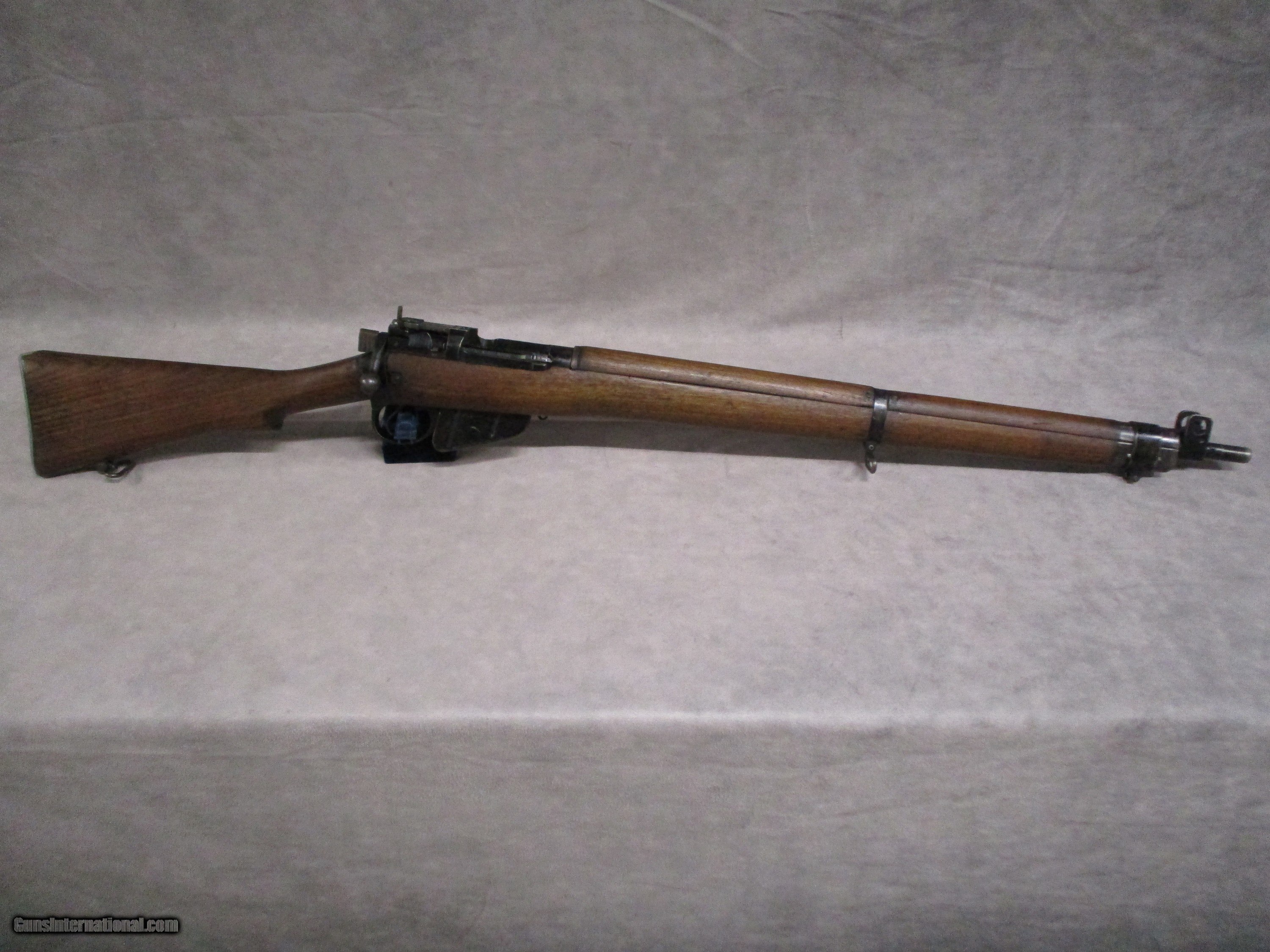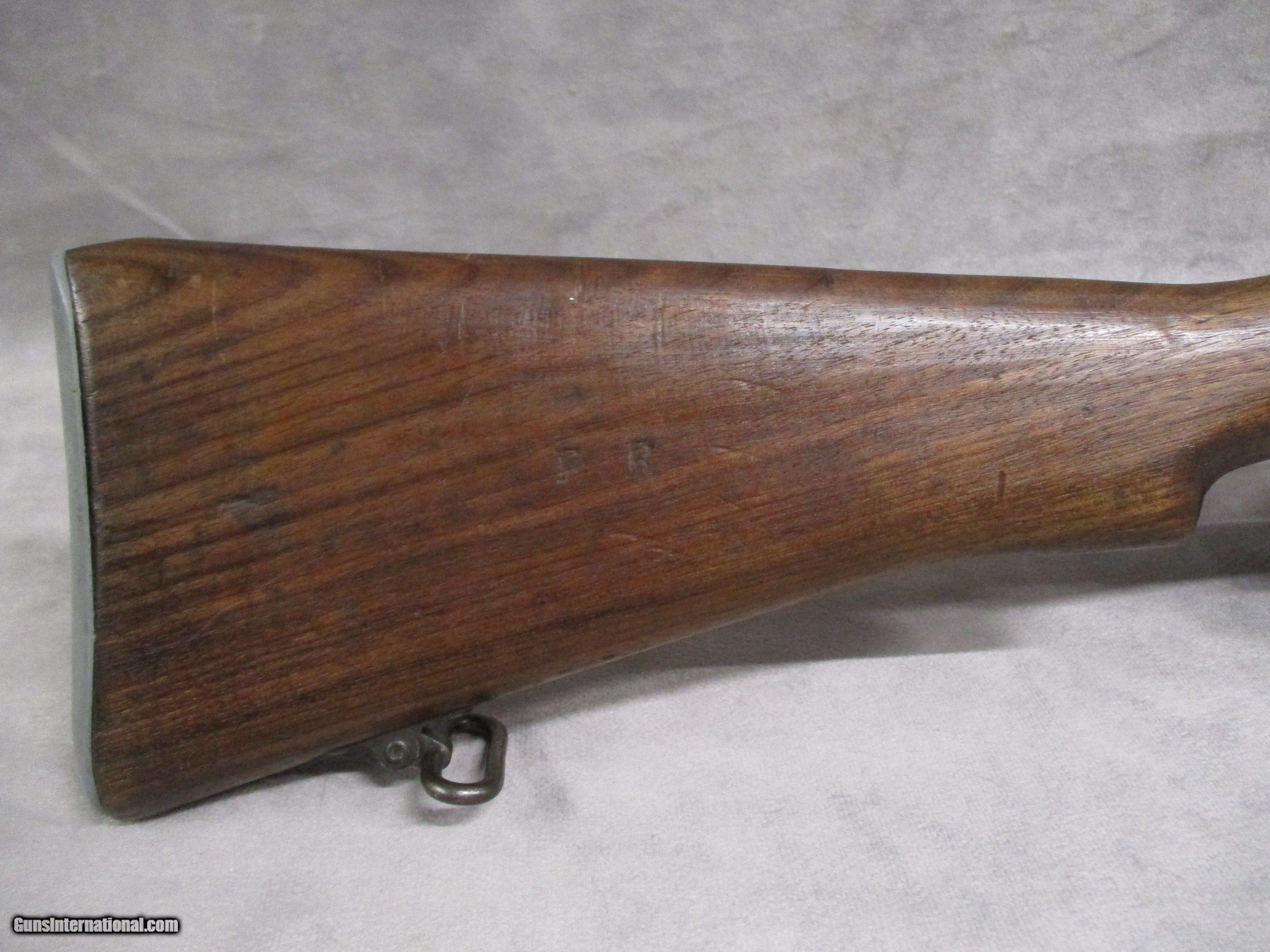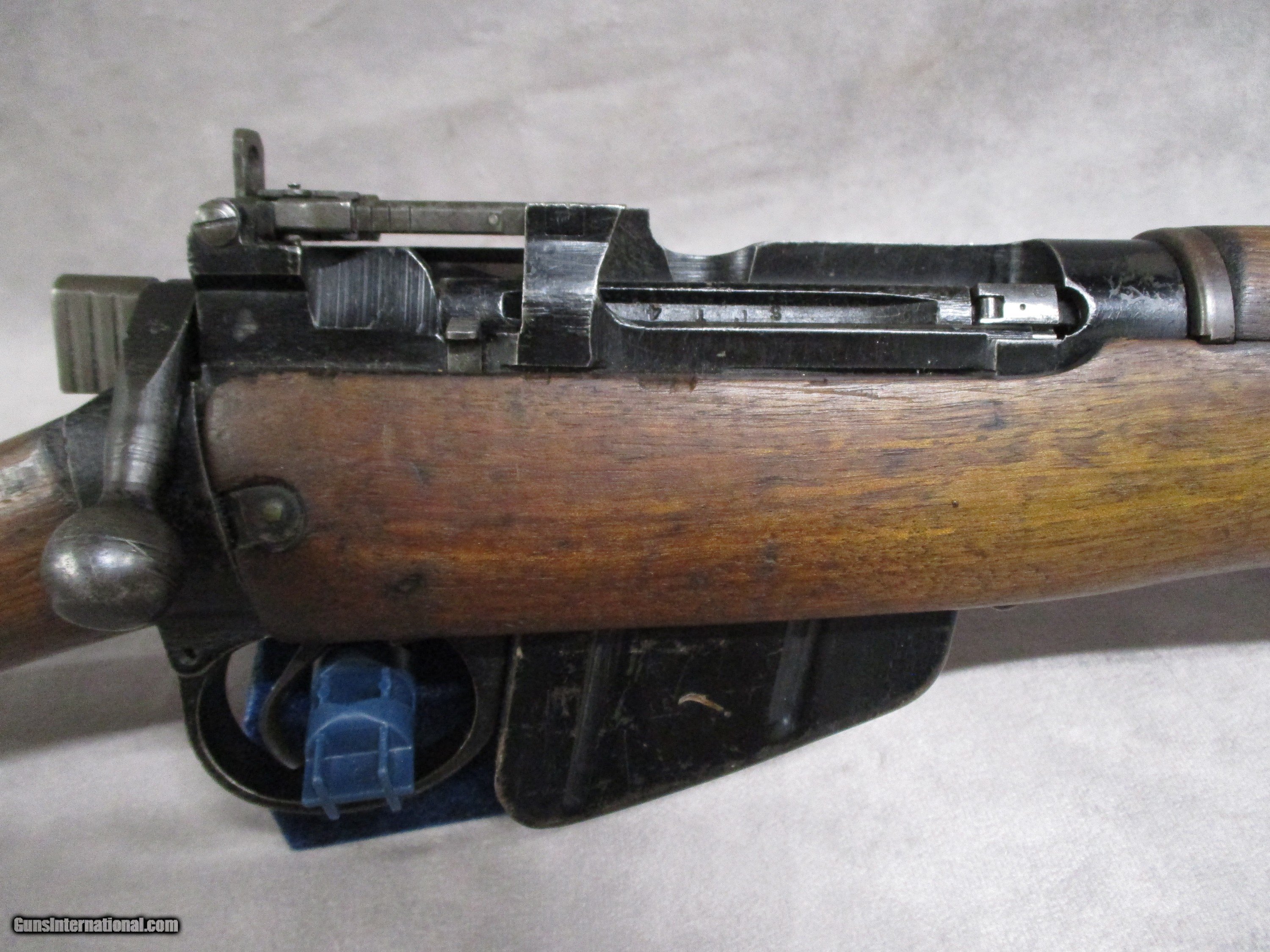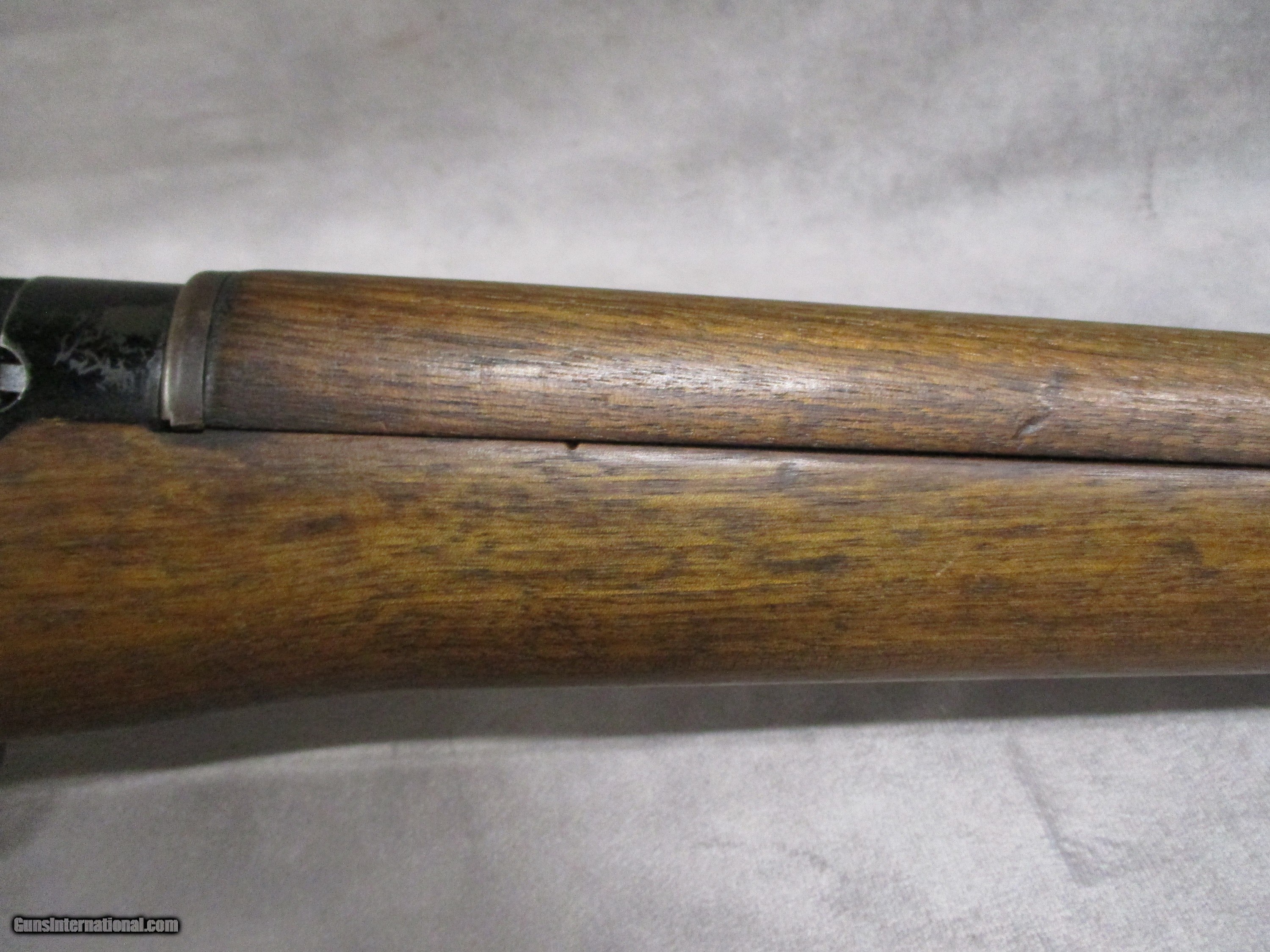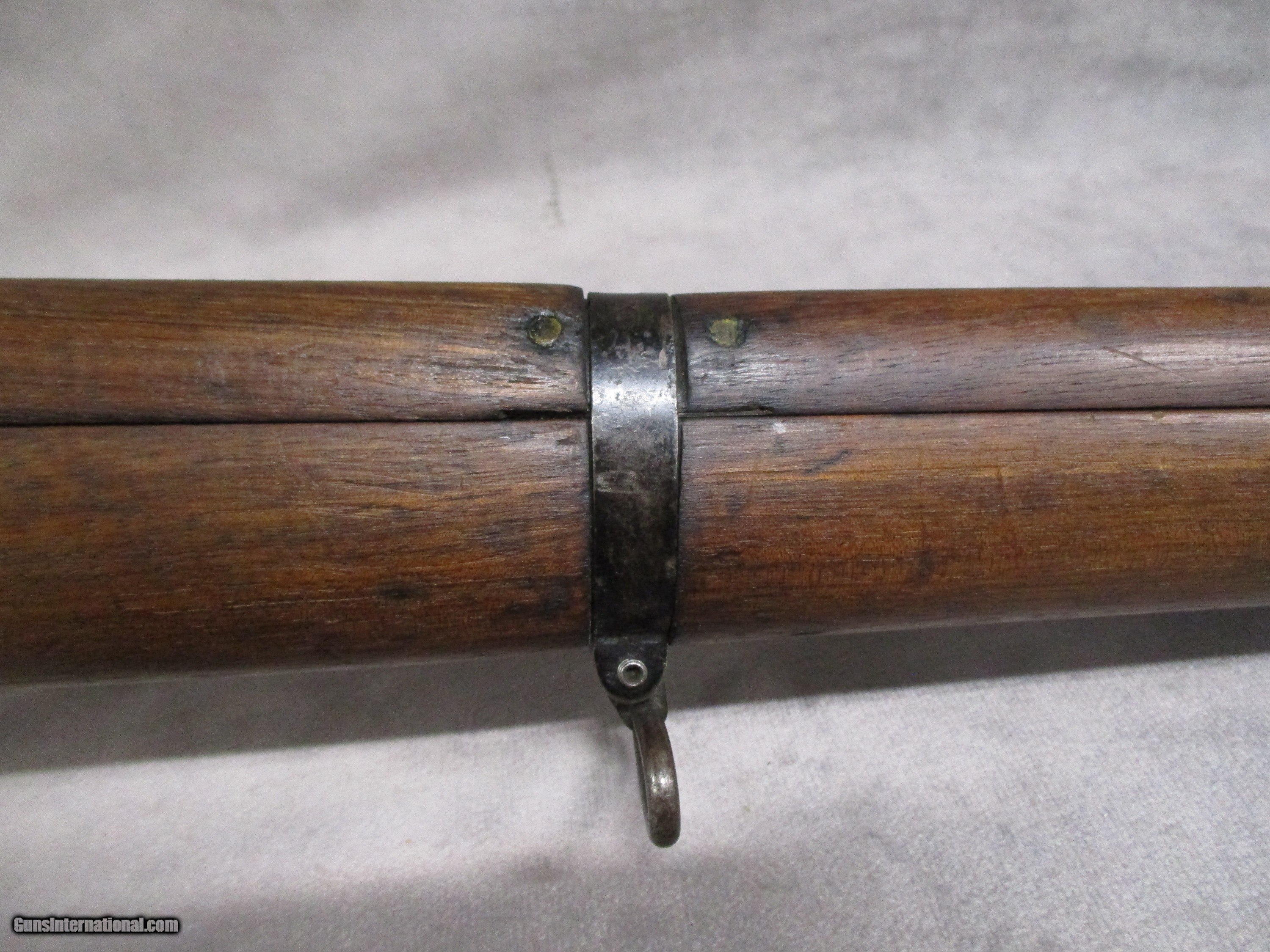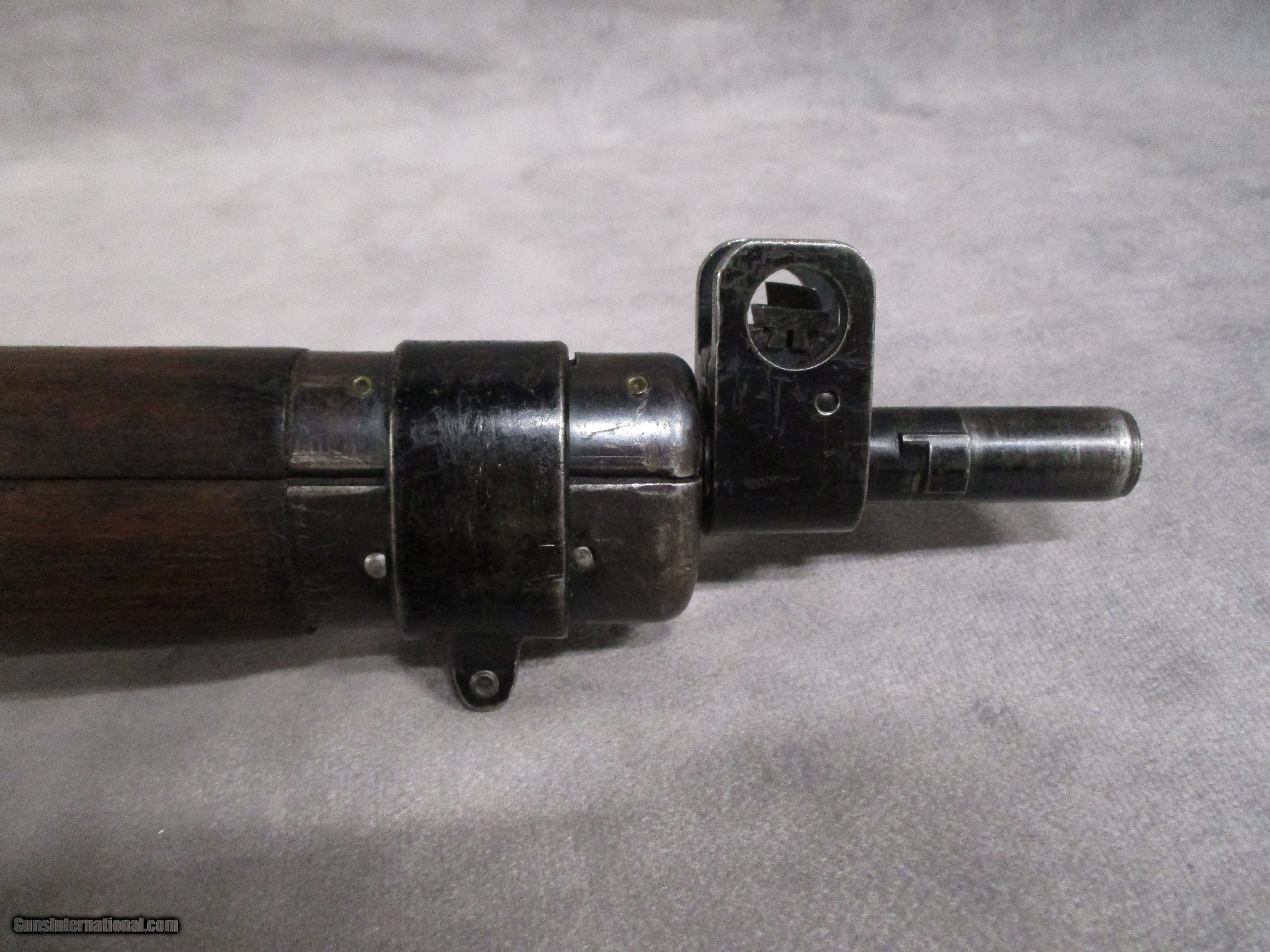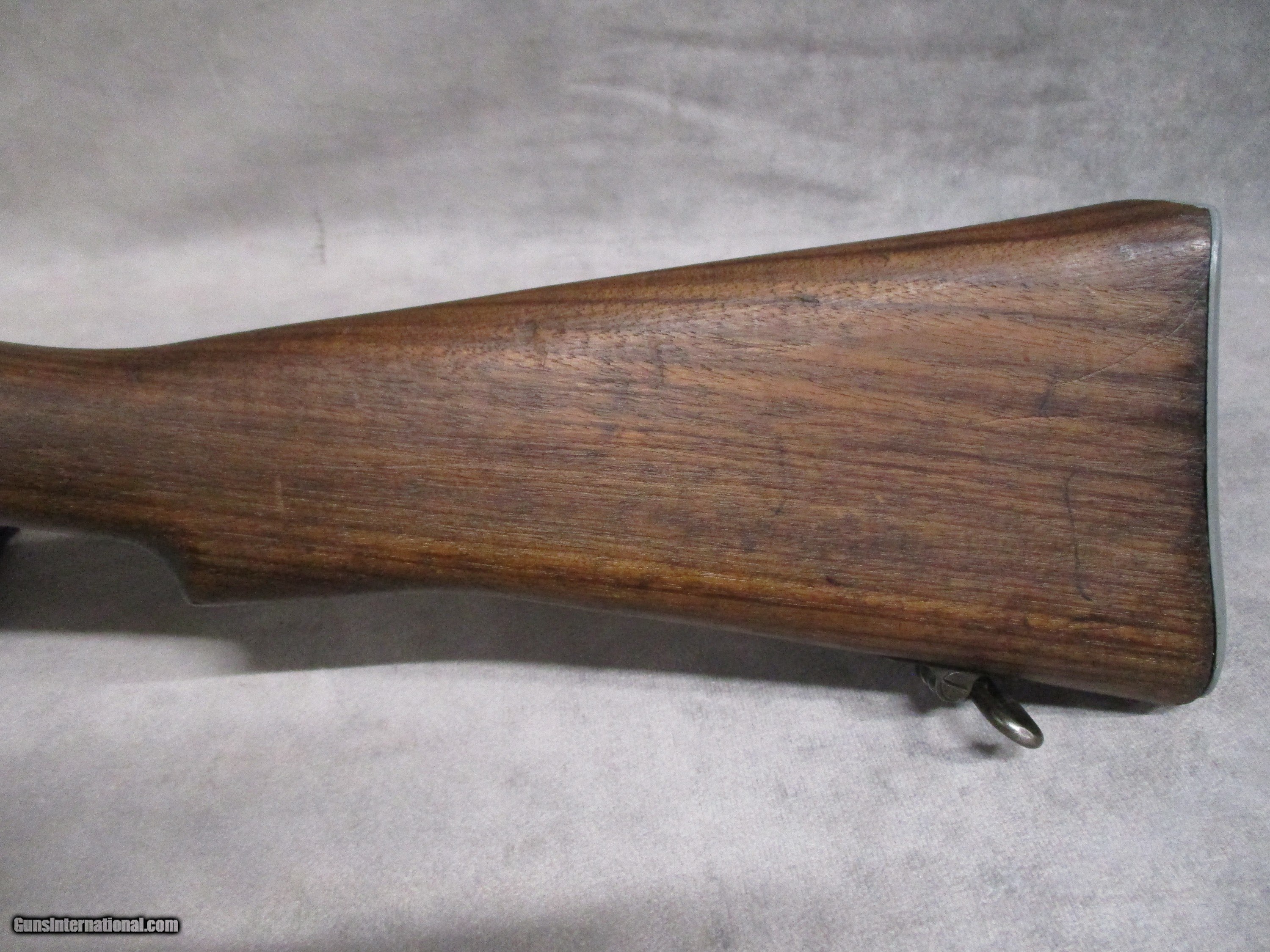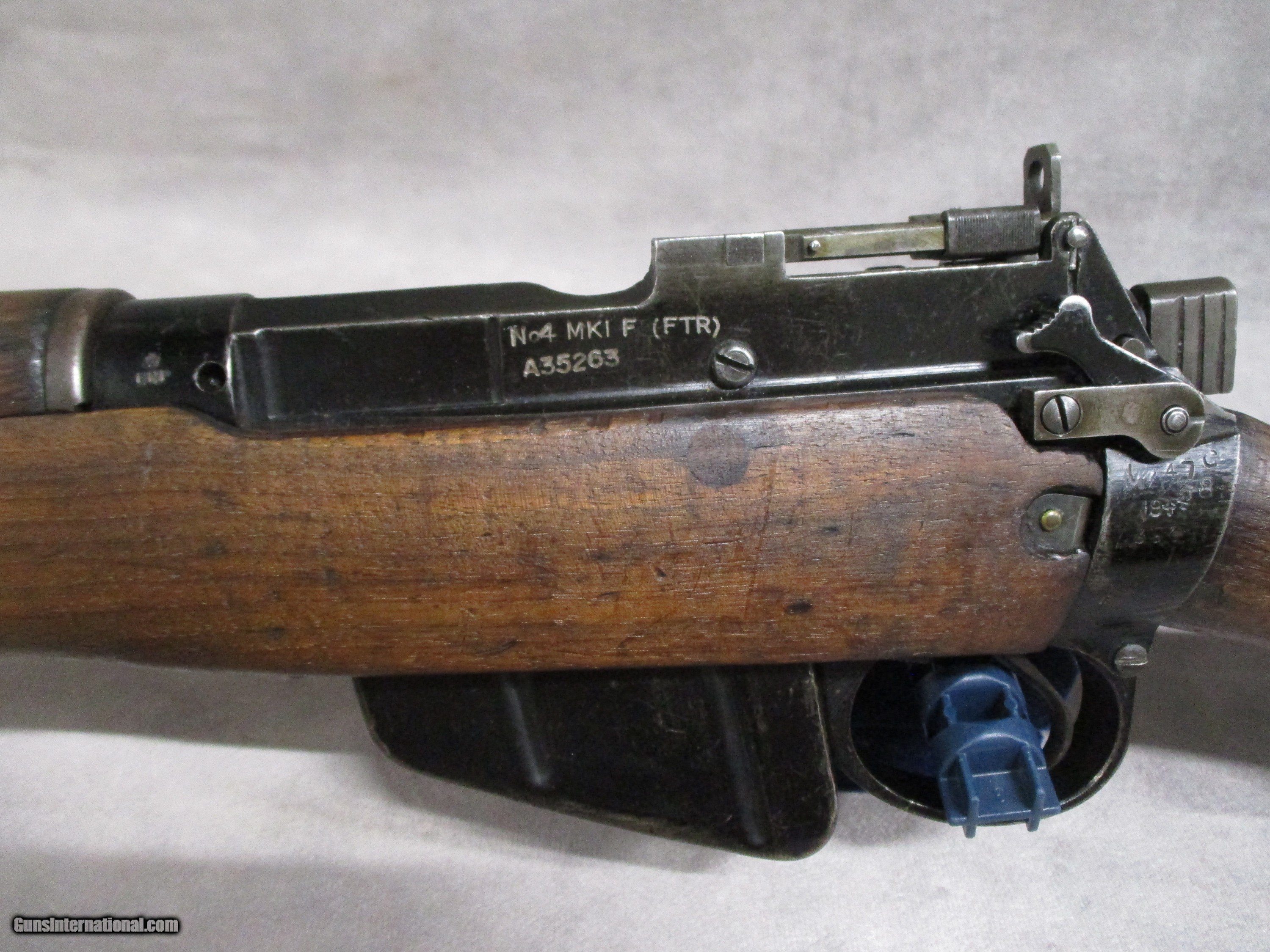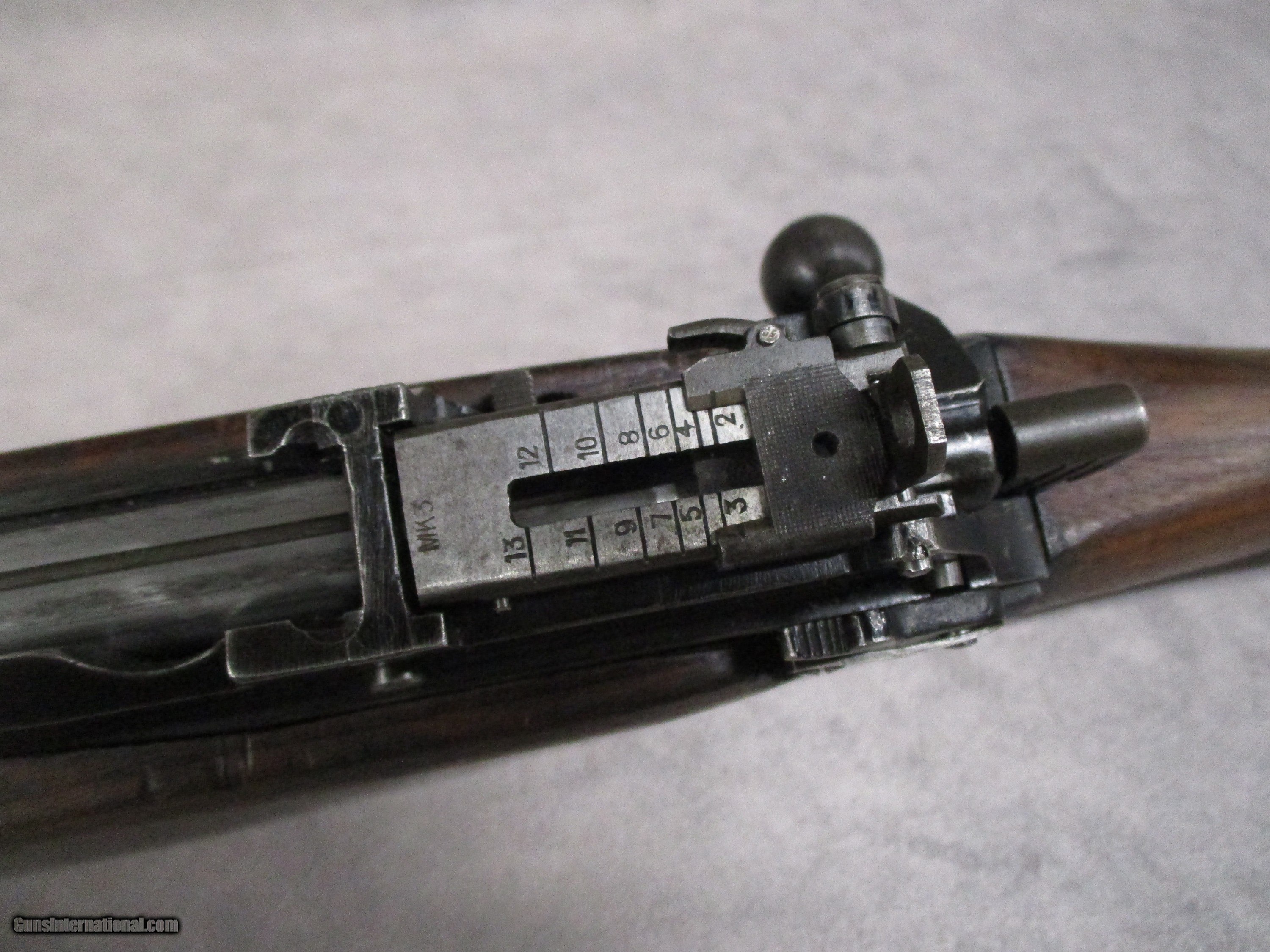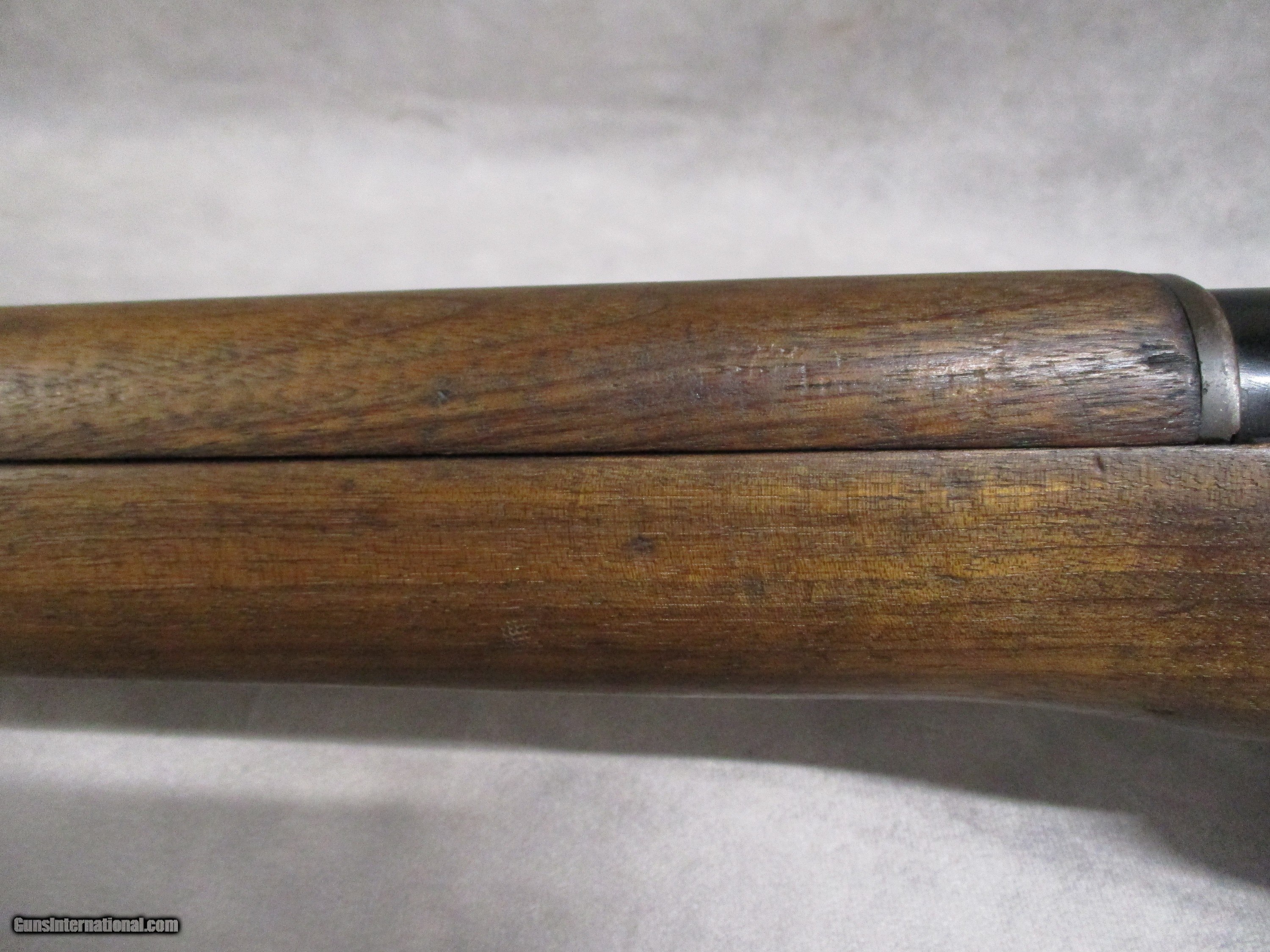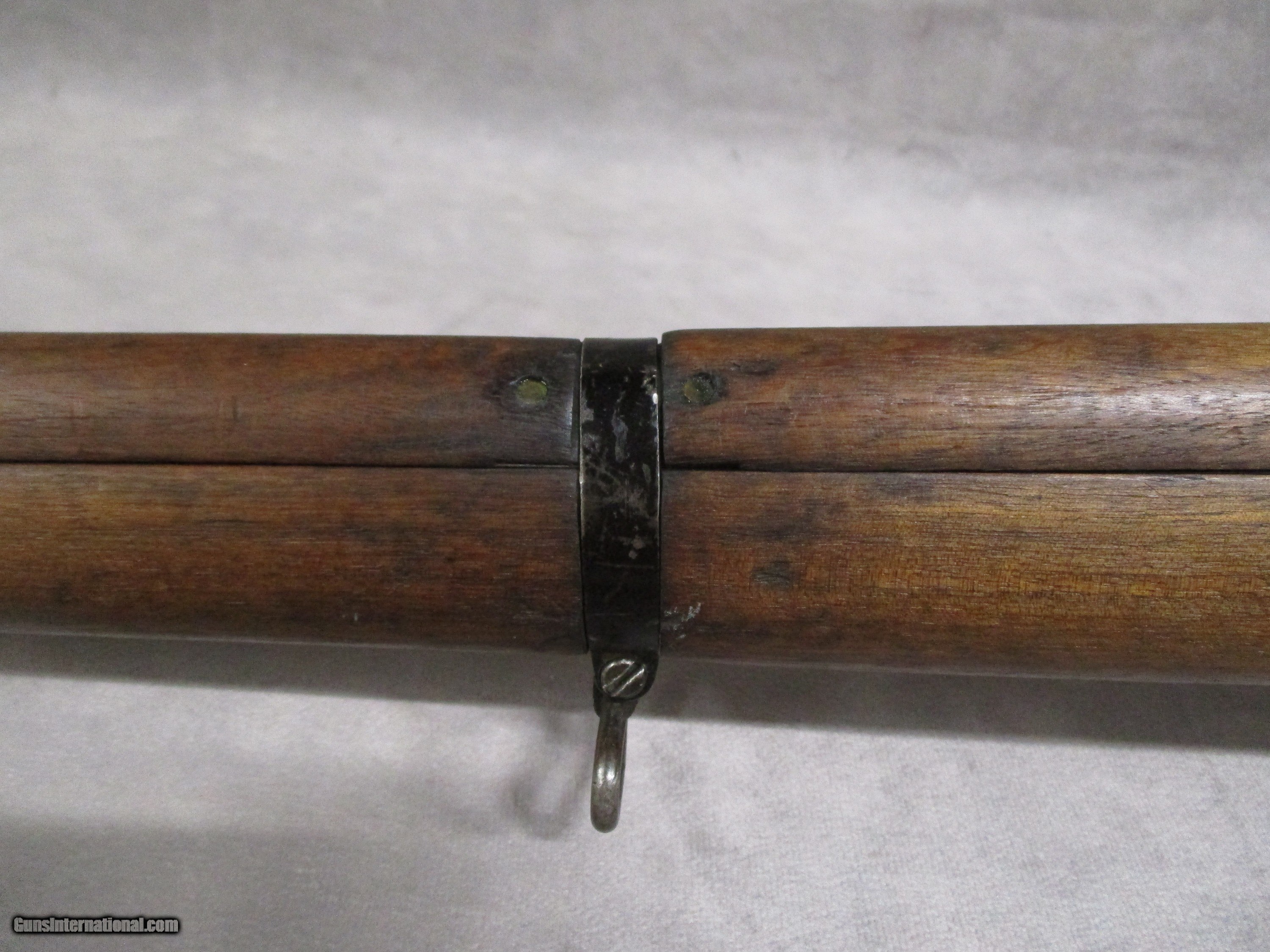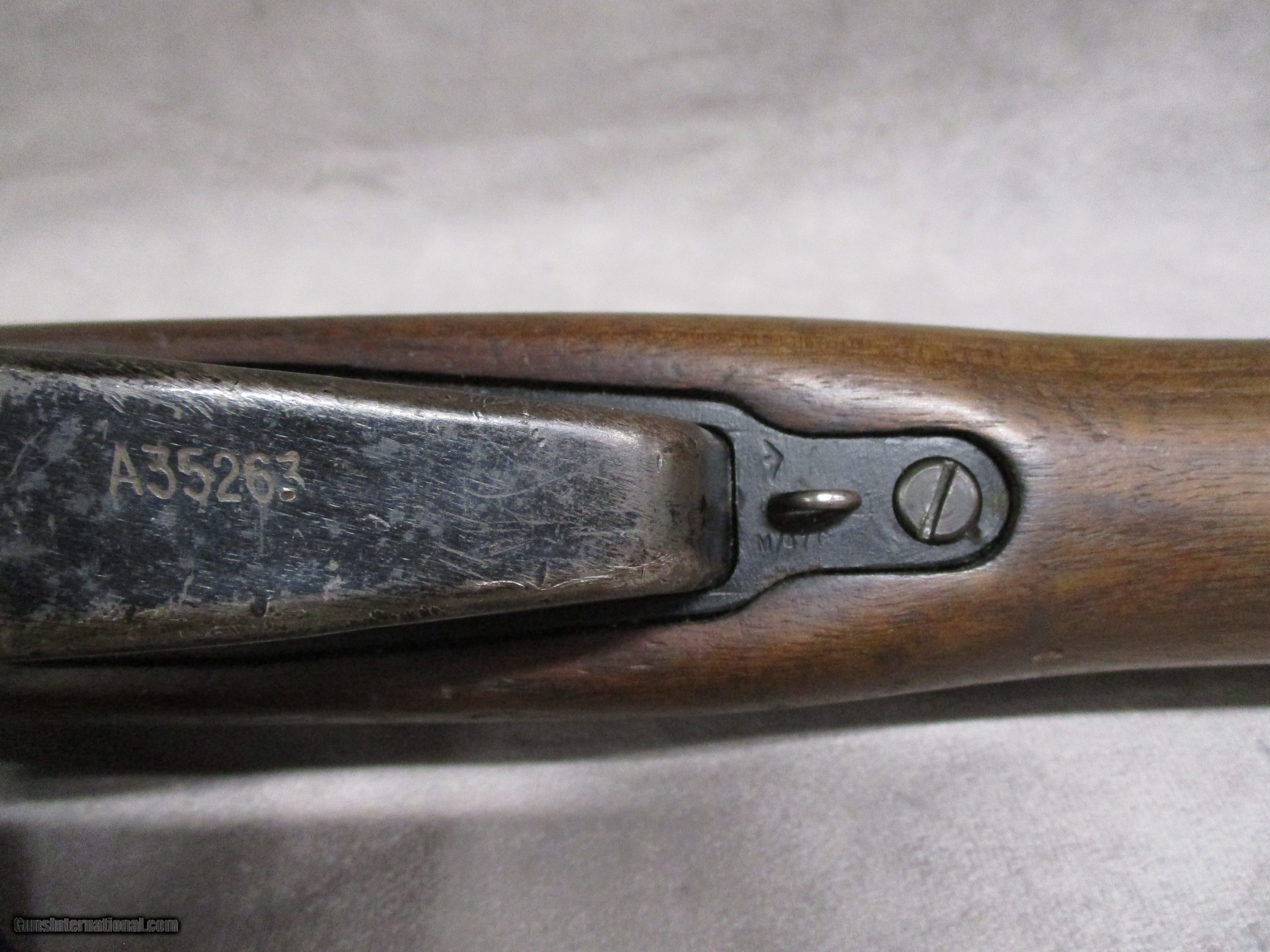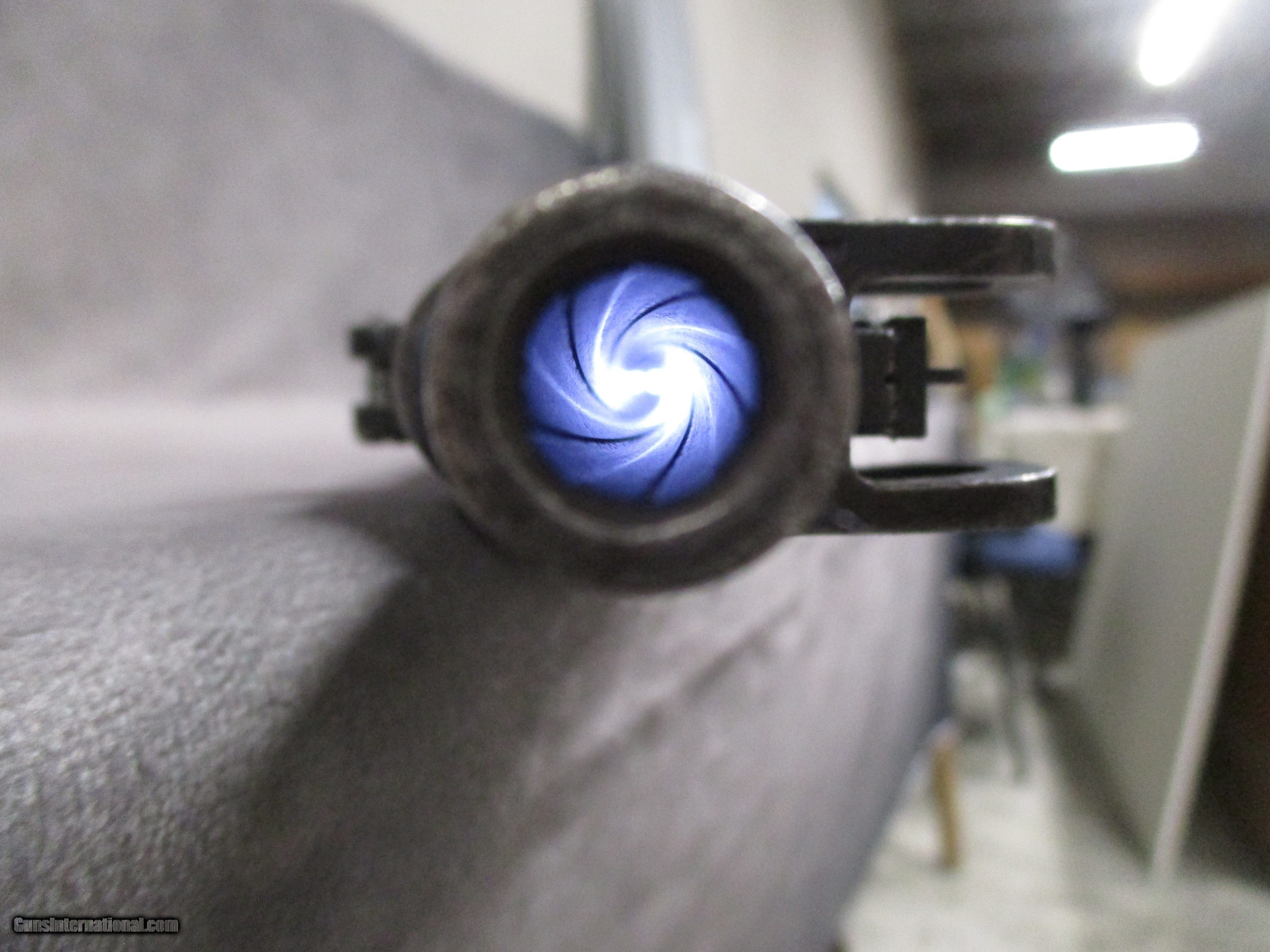Your Session is Ending
 The server has not detected any activity for the last 3 hours.
For your security, your session will expire in 2 minutes and you will be redirected to the Sign In page.
Would you like to stay signed in?
The server has not detected any activity for the last 3 hours.
For your security, your session will expire in 2 minutes and you will be redirected to the Sign In page.
Would you like to stay signed in?
Lee-Enfield No. 4 Mk. 1 .303 British, Circa 1944, Excellent Bore
Lee-Enfield No. 4 Mk. 1 .303 British, Circa 1944, Excellent Bore
Guns International #: 102458411
Seller's Inventory #: 2309-0177
Category - Military Rifles - British
- Military Arms
Seller's Information
When emailing or calling sellers direct,
please mention that you saw their listing on GunsInternational.com
Seller: Shooter's Supply, LLC.
Member Since: 3/16/16
First Name: Patrick
Last Name: Brown
State:
Tennessee
Zip: 37343
Country: United States
Phone:
(423) 875-4868
Active Listings: 69
Total Listings: 1350
Seller Type: FFL Dealer
Return Policy: 3 day inspection and return policy on used guns and accessories. No returns on new firearms.
We normally ship USPS Priority Mail which should be 2-day ship. Shipping is actual cost with a minimum of $30.00 for pistols and $50.00 for rifles/shotguns to ship to most of the 48 contiguous states. Shipping to Alaska may require an extra fee. Shipping insurance is available upon request for an extra fee. We cannot do international sales. As of November 2019, we no longer ship guns to California and Hawaii.
We normally ship USPS Priority Mail which should be 2-day ship. Shipping is actual cost with a minimum of $30.00 for pistols and $50.00 for rifles/shotguns to ship to most of the 48 contiguous states. Shipping to Alaska may require an extra fee. Shipping insurance is available upon request for an extra fee. We cannot do international sales. As of November 2019, we no longer ship guns to California and Hawaii.
Payment Methods: Visa, Master Card, American Express, USPS Money Order. NO CREDIT CARD FEES!!!
About Us: We are a small family owned business located in Hixson, Tennessee. Do you have firearms at home collecting dust? We have a lively consignment business. Our fee is 20% with a $50 minimum. Firearms are consigned for a an average period of 180 days but the length of period is negotiable. We also do handgun carry permit classes for the state of Tennessee. We have a nice indoor shooting range with reasonable rates. Please check us out at shooterssupply.
Lee-Enfield No. 4 Mk. 1 .303 British, Circa 1944, Excellent Bore
Description:
This is one of the most famous bolt-action rifles ever made. The Lee-Enfield served the British empire in one model or another from around the turn-of-the-century to the 1990s. They are still used in certain parts of the world, particularly the Middle East. Unlike the United States, Germany, and the Soviet Union, Great Britain made no attempts to place a semi-auto rifle into production during the Second World War. Like Italy and Japan, Great Britain felt that introducing a new rifle design would cause logistic problems that would be more trouble than it was worth to issue their soldiers with arms comparable to the M1 Garand, Gewehr 43 and SVT-40. In an ironic twist, only the M-1 Garand would see widespread use thanks to the strength of American industry and so could be issued in enough numbers. Both the Germans and Soviets had to continue relying on their older bolt action designs, the Mauser Karabiner 98k and the Mosin-Nagant 1891/30, both stablemates of the Lee-Enfield having been designed around the same timeframe at the end of the 19th Century. Despite being surpassed by semi-auto rifles in other countries, the Lee-Enfield is an excellent design with many advantages over other bolt action designs. It’s cock-on-closing feature enabled fast, well-aimed fire. During some of the early battles of World War 1, British troops engaging in massed fire tactics with the Lee-Enfield No. 1 Mk. III, convinced attacking German soldiers that their opponents were equipped with machine guns. The rifles generous capacity of 10 rounds allowed British soldiers to perform what was called the “mad minute,” wherein the soldier would fire 20 to 30 aimed rounds in 60 seconds. Indeed, the current world record for aimed, bolt-action was set in 1914 by an instructor in the British Army who placed 38 rounds into a 12-inch-wide target at 300 yards in 1 minute. Imagine having to attempt such a feat today. One important note is that while the No. 4 Mk 1 was first issued in late 1939, it was not officially adopted for use until 1941, and by no means did it immediately replace the older models. Thus, many of the Lee-Enfield’s used in the early battles of World War 2 in Europe, North Africa, and the Pacific were the older No. 1 Mk III and No. 1 Mk III*.
The rifle is in good condition. It appears it went through, at some point in time, a rebuild at the Royal Ordnance Factory at Fazakerley as indicated by the “(F)” and “FTR” wherein the former indicates Fazakerley, and the latter stands for “Factory Thorough Repair.” Normally, a date would be stamped after the “FTR” to indicate when the rebuild took place, but this rifle does not appear to have such a marking. The serial numbers for the bolt and magazine both match the serial number on the receiver. The buttsocket is stamped 1944, with the last “4” being stamped above and at an angle to the first 3 numbers. The numbers 47 and 48 are stamped above the 1944, as are a few other letters. It is not certain if either one of these indicates the year the rifle went through its rebuild. The finish is mostly intact with some loss in a few spots, mainly the barrel bands, bolt handle, and receiver bridge. It should be noted that the finish used on the No. 4 bears a strong resemblance to 1940’s car engine paint. This type of finish was used rather the bluing used on the No. 1 Mk. III as it could be applied far more quickly in order to ship the rifle from the factory and be issued, something of critical importance after the debacle at Dunkerque where the British had to leave much of their equipment behind in order to escape from France back to England. The front stock band also exhibits some minor finish loss as well as some scuffing. The barrel, being mostly hidden under the handguard and front sight assembly retains the majority of its finish. The wood is in good shape with the amount of wear you’d expect from an issued military rifle albeit one that has been well taken care of. There aren’t that many dings or dents present. The letters “F” and “R” have been stamped in the wood on the right side. The bore is in great shape. There does appear to be some micro pitting in the grooves near the muzzle, but these are so shallow it is highly unlikely to affect the bullet. Then again, it could just be copper fouling. The rifle should prove to be very accurate provided the shooter does their part. The bolt head is a #0 type. Theoretically, this indicates the size of the bolt head as being between 0.620 and 0.625 inches, however this is not necessarily the case. Bolt head sizes for the Lee Enfield No.4 are not always accurate. In some cases, it is possible to find a #0 that is the same size as a #2 or even a #2 that is smaller than a #1. The cartridge the Lee-Enfield is chambered for, the .303 British, is well known and one of the best rimmed cartridges ever designed. Though not normally as powerful as say, the .308 Winchester, the .303 British is leaps and bounds above the .30-30 and .30-40 Krag cartridges to which it is often compared. In fact, the cartridge tends to be under-loaded at the factory, so it can be used in the older and weaker No.1 Mk III actions. In the No. 4, the cartridge can be handloaded to a higher pressure. For example, the L42 sniper rifle, built using the No. 4 receiver is chambered for the .308 Winchester which operates at 62,000 psi. The .303 is normally loaded to 49,000 psi according to SAAMI. From those numbers you can see how much improvement can be made to the cartridge when used in the No. 4 action.
SOLD
Rifle Caliber: .303 British
Manufacturer: Royal Ordnance Factory at Fazakerley
Model: No. 4 Mk. I
Serial Number: A35263
Bore: Rifled, 5 grooves, 1:10 inches (1 in 254 mm) LH twist
Ejectors: Manual ejection
Condition: Good to Very Good
Barrels: Carbon Steel
Barrel Type: Standard Lee-Enfield
Action: Lee-Enfield action, cock-on-closing
Triggers: Single, serrated
Stock: Beech
Fore End: Beech
Butt Pad: Metal plate
LOP: 13.0 inches (330 mm)
Finish: Matte black
Weight: 8.75 lbs.
Sights: Mk 3 Vertical leaf aperture rear sight, blade front, sight radius 28.5625 inches (725.5 mm)
Manufacture Date: 1944
Description:
This is one of the most famous bolt-action rifles ever made. The Lee-Enfield served the British empire in one model or another from around the turn-of-the-century to the 1990s. They are still used in certain parts of the world, particularly the Middle East. Unlike the United States, Germany, and the Soviet Union, Great Britain made no attempts to place a semi-auto rifle into production during the Second World War. Like Italy and Japan, Great Britain felt that introducing a new rifle design would cause logistic problems that would be more trouble than it was worth to issue their soldiers with arms comparable to the M1 Garand, Gewehr 43 and SVT-40. In an ironic twist, only the M-1 Garand would see widespread use thanks to the strength of American industry and so could be issued in enough numbers. Both the Germans and Soviets had to continue relying on their older bolt action designs, the Mauser Karabiner 98k and the Mosin-Nagant 1891/30, both stablemates of the Lee-Enfield having been designed around the same timeframe at the end of the 19th Century. Despite being surpassed by semi-auto rifles in other countries, the Lee-Enfield is an excellent design with many advantages over other bolt action designs. It’s cock-on-closing feature enabled fast, well-aimed fire. During some of the early battles of World War 1, British troops engaging in massed fire tactics with the Lee-Enfield No. 1 Mk. III, convinced attacking German soldiers that their opponents were equipped with machine guns. The rifles generous capacity of 10 rounds allowed British soldiers to perform what was called the “mad minute,” wherein the soldier would fire 20 to 30 aimed rounds in 60 seconds. Indeed, the current world record for aimed, bolt-action was set in 1914 by an instructor in the British Army who placed 38 rounds into a 12-inch-wide target at 300 yards in 1 minute. Imagine having to attempt such a feat today. One important note is that while the No. 4 Mk 1 was first issued in late 1939, it was not officially adopted for use until 1941, and by no means did it immediately replace the older models. Thus, many of the Lee-Enfield’s used in the early battles of World War 2 in Europe, North Africa, and the Pacific were the older No. 1 Mk III and No. 1 Mk III*.
The rifle is in good condition. It appears it went through, at some point in time, a rebuild at the Royal Ordnance Factory at Fazakerley as indicated by the “(F)” and “FTR” wherein the former indicates Fazakerley, and the latter stands for “Factory Thorough Repair.” Normally, a date would be stamped after the “FTR” to indicate when the rebuild took place, but this rifle does not appear to have such a marking. The serial numbers for the bolt and magazine both match the serial number on the receiver. The buttsocket is stamped 1944, with the last “4” being stamped above and at an angle to the first 3 numbers. The numbers 47 and 48 are stamped above the 1944, as are a few other letters. It is not certain if either one of these indicates the year the rifle went through its rebuild. The finish is mostly intact with some loss in a few spots, mainly the barrel bands, bolt handle, and receiver bridge. It should be noted that the finish used on the No. 4 bears a strong resemblance to 1940’s car engine paint. This type of finish was used rather the bluing used on the No. 1 Mk. III as it could be applied far more quickly in order to ship the rifle from the factory and be issued, something of critical importance after the debacle at Dunkerque where the British had to leave much of their equipment behind in order to escape from France back to England. The front stock band also exhibits some minor finish loss as well as some scuffing. The barrel, being mostly hidden under the handguard and front sight assembly retains the majority of its finish. The wood is in good shape with the amount of wear you’d expect from an issued military rifle albeit one that has been well taken care of. There aren’t that many dings or dents present. The letters “F” and “R” have been stamped in the wood on the right side. The bore is in great shape. There does appear to be some micro pitting in the grooves near the muzzle, but these are so shallow it is highly unlikely to affect the bullet. Then again, it could just be copper fouling. The rifle should prove to be very accurate provided the shooter does their part. The bolt head is a #0 type. Theoretically, this indicates the size of the bolt head as being between 0.620 and 0.625 inches, however this is not necessarily the case. Bolt head sizes for the Lee Enfield No.4 are not always accurate. In some cases, it is possible to find a #0 that is the same size as a #2 or even a #2 that is smaller than a #1. The cartridge the Lee-Enfield is chambered for, the .303 British, is well known and one of the best rimmed cartridges ever designed. Though not normally as powerful as say, the .308 Winchester, the .303 British is leaps and bounds above the .30-30 and .30-40 Krag cartridges to which it is often compared. In fact, the cartridge tends to be under-loaded at the factory, so it can be used in the older and weaker No.1 Mk III actions. In the No. 4, the cartridge can be handloaded to a higher pressure. For example, the L42 sniper rifle, built using the No. 4 receiver is chambered for the .308 Winchester which operates at 62,000 psi. The .303 is normally loaded to 49,000 psi according to SAAMI. From those numbers you can see how much improvement can be made to the cartridge when used in the No. 4 action.
SOLD
Rifle Caliber: .303 British
Manufacturer: Royal Ordnance Factory at Fazakerley
Model: No. 4 Mk. I
Serial Number: A35263
Bore: Rifled, 5 grooves, 1:10 inches (1 in 254 mm) LH twist
Ejectors: Manual ejection
Condition: Good to Very Good
Barrels: Carbon Steel
Barrel Type: Standard Lee-Enfield
Action: Lee-Enfield action, cock-on-closing
Triggers: Single, serrated
Stock: Beech
Fore End: Beech
Butt Pad: Metal plate
LOP: 13.0 inches (330 mm)
Finish: Matte black
Weight: 8.75 lbs.
Sights: Mk 3 Vertical leaf aperture rear sight, blade front, sight radius 28.5625 inches (725.5 mm)
Manufacture Date: 1944
Click Photo to Enlarge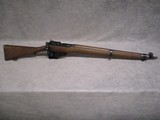
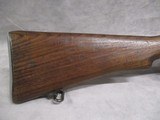
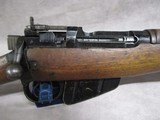
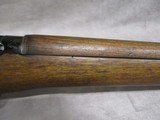
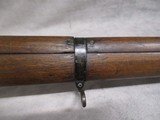
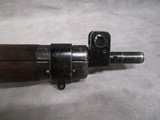
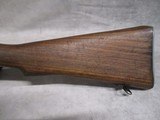
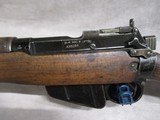
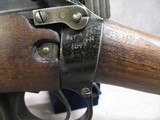
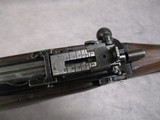
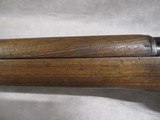
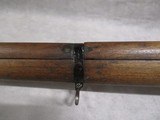
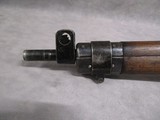
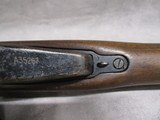
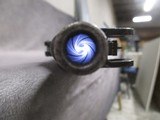
|
Guns International #: 102458411
Category - Military Rifles - British
- Military Arms
Seller's Information
When emailing or calling sellers direct,
please mention that you saw their listing on GunsInternational.com
Seller: Shooter's Supply, LLC.
Member Since: 3/16/16
First Name: Patrick
Last Name: Brown
State:
Tennessee
Zip: 37343
Country: United States
Phone:
(423) 875-4868
Active Listings: 69
Total Listings: 1350
Seller Type: FFL Dealer
Return Policy: 3 day inspection and return policy on used guns and accessories. No returns on new firearms.
We normally ship USPS Priority Mail which should be 2-day ship. Shipping is actual cost with a minimum of $30.00 for pistols and $50.00 for rifles/shotguns to ship to most of the 48 contiguous states. Shipping to Alaska may require an extra fee. Shipping insurance is available upon request for an extra fee. We cannot do international sales. As of November 2019, we no longer ship guns to California and Hawaii. Payment Methods: Visa, Master Card, American Express, USPS Money Order. NO CREDIT CARD FEES!!!
About Us: We are a small family owned business located in Hixson, Tennessee. Do you have firearms at home collecting dust? We have a lively consignment business. Our fee is 20% with a $50 minimum. Firearms are consigned for a an average period of 180 days but the length of period is negotiable. We also do handgun carry permit classes for the state of Tennessee. We have a nice indoor shooting range with reasonable rates. Please check us out at shooterssupply.
Lee-Enfield No. 4 Mk. 1 .303 British, Circa 1944, Excellent Bore
Description: This is one of the most famous bolt-action rifles ever made. The Lee-Enfield served the British empire in one model or another from around the turn-of-the-century to the 1990s. They are still used in certain parts of the world, particularly the Middle East. Unlike the United States, Germany, and the Soviet Union, Great Britain made no attempts to place a semi-auto rifle into production during the Second World War. Like Italy and Japan, Great Britain felt that introducing a new rifle design would cause logistic problems that would be more trouble than it was worth to issue their soldiers with arms comparable to the M1 Garand, Gewehr 43 and SVT-40. In an ironic twist, only the M-1 Garand would see widespread use thanks to the strength of American industry and so could be issued in enough numbers. Both the Germans and Soviets had to continue relying on their older bolt action designs, the Mauser Karabiner 98k and the Mosin-Nagant 1891/30, both stablemates of the Lee-Enfield having been designed around the same timeframe at the end of the 19th Century. Despite being surpassed by semi-auto rifles in other countries, the Lee-Enfield is an excellent design with many advantages over other bolt action designs. It’s cock-on-closing feature enabled fast, well-aimed fire. During some of the early battles of World War 1, British troops engaging in massed fire tactics with the Lee-Enfield No. 1 Mk. III, convinced attacking German soldiers that their opponents were equipped with machine guns. The rifles generous capacity of 10 rounds allowed British soldiers to perform what was called the “mad minute,” wherein the soldier would fire 20 to 30 aimed rounds in 60 seconds. Indeed, the current world record for aimed, bolt-action was set in 1914 by an instructor in the British Army who placed 38 rounds into a 12-inch-wide target at 300 yards in 1 minute. Imagine having to attempt such a feat today. One important note is that while the No. 4 Mk 1 was first issued in late 1939, it was not officially adopted for use until 1941, and by no means did it immediately replace the older models. Thus, many of the Lee-Enfield’s used in the early battles of World War 2 in Europe, North Africa, and the Pacific were the older No. 1 Mk III and No. 1 Mk III*. The rifle is in good condition. It appears it went through, at some point in time, a rebuild at the Royal Ordnance Factory at Fazakerley as indicated by the “(F)” and “FTR” wherein the former indicates Fazakerley, and the latter stands for “Factory Thorough Repair.” Normally, a date would be stamped after the “FTR” to indicate when the rebuild took place, but this rifle does not appear to have such a marking. The serial numbers for the bolt and magazine both match the serial number on the receiver. The buttsocket is stamped 1944, with the last “4” being stamped above and at an angle to the first 3 numbers. The numbers 47 and 48 are stamped above the 1944, as are a few other letters. It is not certain if either one of these indicates the year the rifle went through its rebuild. The finish is mostly intact with some loss in a few spots, mainly the barrel bands, bolt handle, and receiver bridge. It should be noted that the finish used on the No. 4 bears a strong resemblance to 1940’s car engine paint. This type of finish was used rather the bluing used on the No. 1 Mk. III as it could be applied far more quickly in order to ship the rifle from the factory and be issued, something of critical importance after the debacle at Dunkerque where the British had to leave much of their equipment behind in order to escape from France back to England. The front stock band also exhibits some minor finish loss as well as some scuffing. The barrel, being mostly hidden under the handguard and front sight assembly retains the majority of its finish. The wood is in good shape with the amount of wear you’d expect from an issued military rifle albeit one that has been well taken care of. There aren’t that many dings or dents present. The letters “F” and “R” have been stamped in the wood on the right side. The bore is in great shape. There does appear to be some micro pitting in the grooves near the muzzle, but these are so shallow it is highly unlikely to affect the bullet. Then again, it could just be copper fouling. The rifle should prove to be very accurate provided the shooter does their part. The bolt head is a #0 type. Theoretically, this indicates the size of the bolt head as being between 0.620 and 0.625 inches, however this is not necessarily the case. Bolt head sizes for the Lee Enfield No.4 are not always accurate. In some cases, it is possible to find a #0 that is the same size as a #2 or even a #2 that is smaller than a #1. The cartridge the Lee-Enfield is chambered for, the .303 British, is well known and one of the best rimmed cartridges ever designed. Though not normally as powerful as say, the .308 Winchester, the .303 British is leaps and bounds above the .30-30 and .30-40 Krag cartridges to which it is often compared. In fact, the cartridge tends to be under-loaded at the factory, so it can be used in the older and weaker No.1 Mk III actions. In the No. 4, the cartridge can be handloaded to a higher pressure. For example, the L42 sniper rifle, built using the No. 4 receiver is chambered for the .308 Winchester which operates at 62,000 psi. The .303 is normally loaded to 49,000 psi according to SAAMI. From those numbers you can see how much improvement can be made to the cartridge when used in the No. 4 action. SOLD Rifle Caliber: .303 British Manufacturer: Royal Ordnance Factory at Fazakerley Model: No. 4 Mk. I Serial Number: A35263 Bore: Rifled, 5 grooves, 1:10 inches (1 in 254 mm) LH twist Ejectors: Manual ejection Condition: Good to Very Good Barrels: Carbon Steel Barrel Type: Standard Lee-Enfield Action: Lee-Enfield action, cock-on-closing Triggers: Single, serrated Stock: Beech Fore End: Beech Butt Pad: Metal plate LOP: 13.0 inches (330 mm) Finish: Matte black Weight: 8.75 lbs. Sights: Mk 3 Vertical leaf aperture rear sight, blade front, sight radius 28.5625 inches (725.5 mm) Manufacture Date: 1944 |
Guns International #: 102458411
Seller's Inventory #: 2309-0177
Category - Military Rifles - British
- Military Arms
Seller's Information
When emailing or calling sellers direct,
please mention that you saw their listing on GunsInternational.com
Seller: Shooter's Supply, LLC.
Member Since: 3/16/16
First Name: Patrick
Last Name: Brown
State:
Tennessee
Zip: 37343
Country: United States
Phone:
(423) 875-4868
Active Listings: 69
Total Listings: 1350
Seller Type: FFL Dealer
Return Policy: 3 day inspection and return policy on used guns and accessories. No returns on new firearms.
We normally ship USPS Priority Mail which should be 2-day ship. Shipping is actual cost with a minimum of $30.00 for pistols and $50.00 for rifles/shotguns to ship to most of the 48 contiguous states. Shipping to Alaska may require an extra fee. Shipping insurance is available upon request for an extra fee. We cannot do international sales. As of November 2019, we no longer ship guns to California and Hawaii.
We normally ship USPS Priority Mail which should be 2-day ship. Shipping is actual cost with a minimum of $30.00 for pistols and $50.00 for rifles/shotguns to ship to most of the 48 contiguous states. Shipping to Alaska may require an extra fee. Shipping insurance is available upon request for an extra fee. We cannot do international sales. As of November 2019, we no longer ship guns to California and Hawaii.
Payment Methods: Visa, Master Card, American Express, USPS Money Order. NO CREDIT CARD FEES!!!
About Us: We are a small family owned business located in Hixson, Tennessee. Do you have firearms at home collecting dust? We have a lively consignment business. Our fee is 20% with a $50 minimum. Firearms are consigned for a an average period of 180 days but the length of period is negotiable. We also do handgun carry permit classes for the state of Tennessee. We have a nice indoor shooting range with reasonable rates. Please check us out at shooterssupply.
Lee-Enfield No. 4 Mk. 1 .303 British, Circa 1944, Excellent Bore
Description:
This is one of the most famous bolt-action rifles ever made. The Lee-Enfield served the British empire in one model or another from around the turn-of-the-century to the 1990s. They are still used in certain parts of the world, particularly the Middle East. Unlike the United States, Germany, and the Soviet Union, Great Britain made no attempts to place a semi-auto rifle into production during the Second World War. Like Italy and Japan, Great Britain felt that introducing a new rifle design would cause logistic problems that would be more trouble than it was worth to issue their soldiers with arms comparable to the M1 Garand, Gewehr 43 and SVT-40. In an ironic twist, only the M-1 Garand would see widespread use thanks to the strength of American industry and so could be issued in enough numbers. Both the Germans and Soviets had to continue relying on their older bolt action designs, the Mauser Karabiner 98k and the Mosin-Nagant 1891/30, both stablemates of the Lee-Enfield having been designed around the same timeframe at the end of the 19th Century. Despite being surpassed by semi-auto rifles in other countries, the Lee-Enfield is an excellent design with many advantages over other bolt action designs. It’s cock-on-closing feature enabled fast, well-aimed fire. During some of the early battles of World War 1, British troops engaging in massed fire tactics with the Lee-Enfield No. 1 Mk. III, convinced attacking German soldiers that their opponents were equipped with machine guns. The rifles generous capacity of 10 rounds allowed British soldiers to perform what was called the “mad minute,” wherein the soldier would fire 20 to 30 aimed rounds in 60 seconds. Indeed, the current world record for aimed, bolt-action was set in 1914 by an instructor in the British Army who placed 38 rounds into a 12-inch-wide target at 300 yards in 1 minute. Imagine having to attempt such a feat today. One important note is that while the No. 4 Mk 1 was first issued in late 1939, it was not officially adopted for use until 1941, and by no means did it immediately replace the older models. Thus, many of the Lee-Enfield’s used in the early battles of World War 2 in Europe, North Africa, and the Pacific were the older No. 1 Mk III and No. 1 Mk III*.
The rifle is in good condition. It appears it went through, at some point in time, a rebuild at the Royal Ordnance Factory at Fazakerley as indicated by the “(F)” and “FTR” wherein the former indicates Fazakerley, and the latter stands for “Factory Thorough Repair.” Normally, a date would be stamped after the “FTR” to indicate when the rebuild took place, but this rifle does not appear to have such a marking. The serial numbers for the bolt and magazine both match the serial number on the receiver. The buttsocket is stamped 1944, with the last “4” being stamped above and at an angle to the first 3 numbers. The numbers 47 and 48 are stamped above the 1944, as are a few other letters. It is not certain if either one of these indicates the year the rifle went through its rebuild. The finish is mostly intact with some loss in a few spots, mainly the barrel bands, bolt handle, and receiver bridge. It should be noted that the finish used on the No. 4 bears a strong resemblance to 1940’s car engine paint. This type of finish was used rather the bluing used on the No. 1 Mk. III as it could be applied far more quickly in order to ship the rifle from the factory and be issued, something of critical importance after the debacle at Dunkerque where the British had to leave much of their equipment behind in order to escape from France back to England. The front stock band also exhibits some minor finish loss as well as some scuffing. The barrel, being mostly hidden under the handguard and front sight assembly retains the majority of its finish. The wood is in good shape with the amount of wear you’d expect from an issued military rifle albeit one that has been well taken care of. There aren’t that many dings or dents present. The letters “F” and “R” have been stamped in the wood on the right side. The bore is in great shape. There does appear to be some micro pitting in the grooves near the muzzle, but these are so shallow it is highly unlikely to affect the bullet. Then again, it could just be copper fouling. The rifle should prove to be very accurate provided the shooter does their part. The bolt head is a #0 type. Theoretically, this indicates the size of the bolt head as being between 0.620 and 0.625 inches, however this is not necessarily the case. Bolt head sizes for the Lee Enfield No.4 are not always accurate. In some cases, it is possible to find a #0 that is the same size as a #2 or even a #2 that is smaller than a #1. The cartridge the Lee-Enfield is chambered for, the .303 British, is well known and one of the best rimmed cartridges ever designed. Though not normally as powerful as say, the .308 Winchester, the .303 British is leaps and bounds above the .30-30 and .30-40 Krag cartridges to which it is often compared. In fact, the cartridge tends to be under-loaded at the factory, so it can be used in the older and weaker No.1 Mk III actions. In the No. 4, the cartridge can be handloaded to a higher pressure. For example, the L42 sniper rifle, built using the No. 4 receiver is chambered for the .308 Winchester which operates at 62,000 psi. The .303 is normally loaded to 49,000 psi according to SAAMI. From those numbers you can see how much improvement can be made to the cartridge when used in the No. 4 action.
SOLD
Rifle Caliber: .303 British
Manufacturer: Royal Ordnance Factory at Fazakerley
Model: No. 4 Mk. I
Serial Number: A35263
Bore: Rifled, 5 grooves, 1:10 inches (1 in 254 mm) LH twist
Ejectors: Manual ejection
Condition: Good to Very Good
Barrels: Carbon Steel
Barrel Type: Standard Lee-Enfield
Action: Lee-Enfield action, cock-on-closing
Triggers: Single, serrated
Stock: Beech
Fore End: Beech
Butt Pad: Metal plate
LOP: 13.0 inches (330 mm)
Finish: Matte black
Weight: 8.75 lbs.
Sights: Mk 3 Vertical leaf aperture rear sight, blade front, sight radius 28.5625 inches (725.5 mm)
Manufacture Date: 1944
Description:
This is one of the most famous bolt-action rifles ever made. The Lee-Enfield served the British empire in one model or another from around the turn-of-the-century to the 1990s. They are still used in certain parts of the world, particularly the Middle East. Unlike the United States, Germany, and the Soviet Union, Great Britain made no attempts to place a semi-auto rifle into production during the Second World War. Like Italy and Japan, Great Britain felt that introducing a new rifle design would cause logistic problems that would be more trouble than it was worth to issue their soldiers with arms comparable to the M1 Garand, Gewehr 43 and SVT-40. In an ironic twist, only the M-1 Garand would see widespread use thanks to the strength of American industry and so could be issued in enough numbers. Both the Germans and Soviets had to continue relying on their older bolt action designs, the Mauser Karabiner 98k and the Mosin-Nagant 1891/30, both stablemates of the Lee-Enfield having been designed around the same timeframe at the end of the 19th Century. Despite being surpassed by semi-auto rifles in other countries, the Lee-Enfield is an excellent design with many advantages over other bolt action designs. It’s cock-on-closing feature enabled fast, well-aimed fire. During some of the early battles of World War 1, British troops engaging in massed fire tactics with the Lee-Enfield No. 1 Mk. III, convinced attacking German soldiers that their opponents were equipped with machine guns. The rifles generous capacity of 10 rounds allowed British soldiers to perform what was called the “mad minute,” wherein the soldier would fire 20 to 30 aimed rounds in 60 seconds. Indeed, the current world record for aimed, bolt-action was set in 1914 by an instructor in the British Army who placed 38 rounds into a 12-inch-wide target at 300 yards in 1 minute. Imagine having to attempt such a feat today. One important note is that while the No. 4 Mk 1 was first issued in late 1939, it was not officially adopted for use until 1941, and by no means did it immediately replace the older models. Thus, many of the Lee-Enfield’s used in the early battles of World War 2 in Europe, North Africa, and the Pacific were the older No. 1 Mk III and No. 1 Mk III*.
The rifle is in good condition. It appears it went through, at some point in time, a rebuild at the Royal Ordnance Factory at Fazakerley as indicated by the “(F)” and “FTR” wherein the former indicates Fazakerley, and the latter stands for “Factory Thorough Repair.” Normally, a date would be stamped after the “FTR” to indicate when the rebuild took place, but this rifle does not appear to have such a marking. The serial numbers for the bolt and magazine both match the serial number on the receiver. The buttsocket is stamped 1944, with the last “4” being stamped above and at an angle to the first 3 numbers. The numbers 47 and 48 are stamped above the 1944, as are a few other letters. It is not certain if either one of these indicates the year the rifle went through its rebuild. The finish is mostly intact with some loss in a few spots, mainly the barrel bands, bolt handle, and receiver bridge. It should be noted that the finish used on the No. 4 bears a strong resemblance to 1940’s car engine paint. This type of finish was used rather the bluing used on the No. 1 Mk. III as it could be applied far more quickly in order to ship the rifle from the factory and be issued, something of critical importance after the debacle at Dunkerque where the British had to leave much of their equipment behind in order to escape from France back to England. The front stock band also exhibits some minor finish loss as well as some scuffing. The barrel, being mostly hidden under the handguard and front sight assembly retains the majority of its finish. The wood is in good shape with the amount of wear you’d expect from an issued military rifle albeit one that has been well taken care of. There aren’t that many dings or dents present. The letters “F” and “R” have been stamped in the wood on the right side. The bore is in great shape. There does appear to be some micro pitting in the grooves near the muzzle, but these are so shallow it is highly unlikely to affect the bullet. Then again, it could just be copper fouling. The rifle should prove to be very accurate provided the shooter does their part. The bolt head is a #0 type. Theoretically, this indicates the size of the bolt head as being between 0.620 and 0.625 inches, however this is not necessarily the case. Bolt head sizes for the Lee Enfield No.4 are not always accurate. In some cases, it is possible to find a #0 that is the same size as a #2 or even a #2 that is smaller than a #1. The cartridge the Lee-Enfield is chambered for, the .303 British, is well known and one of the best rimmed cartridges ever designed. Though not normally as powerful as say, the .308 Winchester, the .303 British is leaps and bounds above the .30-30 and .30-40 Krag cartridges to which it is often compared. In fact, the cartridge tends to be under-loaded at the factory, so it can be used in the older and weaker No.1 Mk III actions. In the No. 4, the cartridge can be handloaded to a higher pressure. For example, the L42 sniper rifle, built using the No. 4 receiver is chambered for the .308 Winchester which operates at 62,000 psi. The .303 is normally loaded to 49,000 psi according to SAAMI. From those numbers you can see how much improvement can be made to the cartridge when used in the No. 4 action.
SOLD
Rifle Caliber: .303 British
Manufacturer: Royal Ordnance Factory at Fazakerley
Model: No. 4 Mk. I
Serial Number: A35263
Bore: Rifled, 5 grooves, 1:10 inches (1 in 254 mm) LH twist
Ejectors: Manual ejection
Condition: Good to Very Good
Barrels: Carbon Steel
Barrel Type: Standard Lee-Enfield
Action: Lee-Enfield action, cock-on-closing
Triggers: Single, serrated
Stock: Beech
Fore End: Beech
Butt Pad: Metal plate
LOP: 13.0 inches (330 mm)
Finish: Matte black
Weight: 8.75 lbs.
Sights: Mk 3 Vertical leaf aperture rear sight, blade front, sight radius 28.5625 inches (725.5 mm)
Manufacture Date: 1944
Guns International #: 102458411
Seller's Inventory #: 2309-0177


Guns International #: 102458411
Seller's Inventory #: 2309-0177
Category - Military Rifles - British
- Military Arms
Seller's Information
When emailing or calling sellers direct,
please mention that you saw their listing on GunsInternational.com
Seller: Shooter's Supply, LLC.
Member Since: 3/16/16
First Name: Patrick
Last Name: Brown
State:
Tennessee
Zip: 37343
Country: United States
Phone:
(423) 875-4868
Active Listings: 69
Total Listings: 1350
Seller Type: FFL Dealer
Return Policy: 3 day inspection and return policy on used guns and accessories. No returns on new firearms.
We normally ship USPS Priority Mail which should be 2-day ship. Shipping is actual cost with a minimum of $30.00 for pistols and $50.00 for rifles/shotguns to ship to most of the 48 contiguous states. Shipping to Alaska may require an extra fee. Shipping insurance is available upon request for an extra fee. We cannot do international sales. As of November 2019, we no longer ship guns to California and Hawaii.
We normally ship USPS Priority Mail which should be 2-day ship. Shipping is actual cost with a minimum of $30.00 for pistols and $50.00 for rifles/shotguns to ship to most of the 48 contiguous states. Shipping to Alaska may require an extra fee. Shipping insurance is available upon request for an extra fee. We cannot do international sales. As of November 2019, we no longer ship guns to California and Hawaii.
Payment Methods: Visa, Master Card, American Express, USPS Money Order. NO CREDIT CARD FEES!!!
About Us: We are a small family owned business located in Hixson, Tennessee. Do you have firearms at home collecting dust? We have a lively consignment business. Our fee is 20% with a $50 minimum. Firearms are consigned for a an average period of 180 days but the length of period is negotiable. We also do handgun carry permit classes for the state of Tennessee. We have a nice indoor shooting range with reasonable rates. Please check us out at shooterssupply.
Lee-Enfield No. 4 Mk. 1 .303 British, Circa 1944, Excellent Bore
Description:
This is one of the most famous bolt-action rifles ever made. The Lee-Enfield served the British empire in one model or another from around the turn-of-the-century to the 1990s. They are still used in certain parts of the world, particularly the Middle East. Unlike the United States, Germany, and the Soviet Union, Great Britain made no attempts to place a semi-auto rifle into production during the Second World War. Like Italy and Japan, Great Britain felt that introducing a new rifle design would cause logistic problems that would be more trouble than it was worth to issue their soldiers with arms comparable to the M1 Garand, Gewehr 43 and SVT-40. In an ironic twist, only the M-1 Garand would see widespread use thanks to the strength of American industry and so could be issued in enough numbers. Both the Germans and Soviets had to continue relying on their older bolt action designs, the Mauser Karabiner 98k and the Mosin-Nagant 1891/30, both stablemates of the Lee-Enfield having been designed around the same timeframe at the end of the 19th Century. Despite being surpassed by semi-auto rifles in other countries, the Lee-Enfield is an excellent design with many advantages over other bolt action designs. It’s cock-on-closing feature enabled fast, well-aimed fire. During some of the early battles of World War 1, British troops engaging in massed fire tactics with the Lee-Enfield No. 1 Mk. III, convinced attacking German soldiers that their opponents were equipped with machine guns. The rifles generous capacity of 10 rounds allowed British soldiers to perform what was called the “mad minute,” wherein the soldier would fire 20 to 30 aimed rounds in 60 seconds. Indeed, the current world record for aimed, bolt-action was set in 1914 by an instructor in the British Army who placed 38 rounds into a 12-inch-wide target at 300 yards in 1 minute. Imagine having to attempt such a feat today. One important note is that while the No. 4 Mk 1 was first issued in late 1939, it was not officially adopted for use until 1941, and by no means did it immediately replace the older models. Thus, many of the Lee-Enfield’s used in the early battles of World War 2 in Europe, North Africa, and the Pacific were the older No. 1 Mk III and No. 1 Mk III*.
The rifle is in good condition. It appears it went through, at some point in time, a rebuild at the Royal Ordnance Factory at Fazakerley as indicated by the “(F)” and “FTR” wherein the former indicates Fazakerley, and the latter stands for “Factory Thorough Repair.” Normally, a date would be stamped after the “FTR” to indicate when the rebuild took place, but this rifle does not appear to have such a marking. The serial numbers for the bolt and magazine both match the serial number on the receiver. The buttsocket is stamped 1944, with the last “4” being stamped above and at an angle to the first 3 numbers. The numbers 47 and 48 are stamped above the 1944, as are a few other letters. It is not certain if either one of these indicates the year the rifle went through its rebuild. The finish is mostly intact with some loss in a few spots, mainly the barrel bands, bolt handle, and receiver bridge. It should be noted that the finish used on the No. 4 bears a strong resemblance to 1940’s car engine paint. This type of finish was used rather the bluing used on the No. 1 Mk. III as it could be applied far more quickly in order to ship the rifle from the factory and be issued, something of critical importance after the debacle at Dunkerque where the British had to leave much of their equipment behind in order to escape from France back to England. The front stock band also exhibits some minor finish loss as well as some scuffing. The barrel, being mostly hidden under the handguard and front sight assembly retains the majority of its finish. The wood is in good shape with the amount of wear you’d expect from an issued military rifle albeit one that has been well taken care of. There aren’t that many dings or dents present. The letters “F” and “R” have been stamped in the wood on the right side. The bore is in great shape. There does appear to be some micro pitting in the grooves near the muzzle, but these are so shallow it is highly unlikely to affect the bullet. Then again, it could just be copper fouling. The rifle should prove to be very accurate provided the shooter does their part. The bolt head is a #0 type. Theoretically, this indicates the size of the bolt head as being between 0.620 and 0.625 inches, however this is not necessarily the case. Bolt head sizes for the Lee Enfield No.4 are not always accurate. In some cases, it is possible to find a #0 that is the same size as a #2 or even a #2 that is smaller than a #1. The cartridge the Lee-Enfield is chambered for, the .303 British, is well known and one of the best rimmed cartridges ever designed. Though not normally as powerful as say, the .308 Winchester, the .303 British is leaps and bounds above the .30-30 and .30-40 Krag cartridges to which it is often compared. In fact, the cartridge tends to be under-loaded at the factory, so it can be used in the older and weaker No.1 Mk III actions. In the No. 4, the cartridge can be handloaded to a higher pressure. For example, the L42 sniper rifle, built using the No. 4 receiver is chambered for the .308 Winchester which operates at 62,000 psi. The .303 is normally loaded to 49,000 psi according to SAAMI. From those numbers you can see how much improvement can be made to the cartridge when used in the No. 4 action.
SOLD
Rifle Caliber: .303 British
Manufacturer: Royal Ordnance Factory at Fazakerley
Model: No. 4 Mk. I
Serial Number: A35263
Bore: Rifled, 5 grooves, 1:10 inches (1 in 254 mm) LH twist
Ejectors: Manual ejection
Condition: Good to Very Good
Barrels: Carbon Steel
Barrel Type: Standard Lee-Enfield
Action: Lee-Enfield action, cock-on-closing
Triggers: Single, serrated
Stock: Beech
Fore End: Beech
Butt Pad: Metal plate
LOP: 13.0 inches (330 mm)
Finish: Matte black
Weight: 8.75 lbs.
Sights: Mk 3 Vertical leaf aperture rear sight, blade front, sight radius 28.5625 inches (725.5 mm)
Manufacture Date: 1944
Description:
This is one of the most famous bolt-action rifles ever made. The Lee-Enfield served the British empire in one model or another from around the turn-of-the-century to the 1990s. They are still used in certain parts of the world, particularly the Middle East. Unlike the United States, Germany, and the Soviet Union, Great Britain made no attempts to place a semi-auto rifle into production during the Second World War. Like Italy and Japan, Great Britain felt that introducing a new rifle design would cause logistic problems that would be more trouble than it was worth to issue their soldiers with arms comparable to the M1 Garand, Gewehr 43 and SVT-40. In an ironic twist, only the M-1 Garand would see widespread use thanks to the strength of American industry and so could be issued in enough numbers. Both the Germans and Soviets had to continue relying on their older bolt action designs, the Mauser Karabiner 98k and the Mosin-Nagant 1891/30, both stablemates of the Lee-Enfield having been designed around the same timeframe at the end of the 19th Century. Despite being surpassed by semi-auto rifles in other countries, the Lee-Enfield is an excellent design with many advantages over other bolt action designs. It’s cock-on-closing feature enabled fast, well-aimed fire. During some of the early battles of World War 1, British troops engaging in massed fire tactics with the Lee-Enfield No. 1 Mk. III, convinced attacking German soldiers that their opponents were equipped with machine guns. The rifles generous capacity of 10 rounds allowed British soldiers to perform what was called the “mad minute,” wherein the soldier would fire 20 to 30 aimed rounds in 60 seconds. Indeed, the current world record for aimed, bolt-action was set in 1914 by an instructor in the British Army who placed 38 rounds into a 12-inch-wide target at 300 yards in 1 minute. Imagine having to attempt such a feat today. One important note is that while the No. 4 Mk 1 was first issued in late 1939, it was not officially adopted for use until 1941, and by no means did it immediately replace the older models. Thus, many of the Lee-Enfield’s used in the early battles of World War 2 in Europe, North Africa, and the Pacific were the older No. 1 Mk III and No. 1 Mk III*.
The rifle is in good condition. It appears it went through, at some point in time, a rebuild at the Royal Ordnance Factory at Fazakerley as indicated by the “(F)” and “FTR” wherein the former indicates Fazakerley, and the latter stands for “Factory Thorough Repair.” Normally, a date would be stamped after the “FTR” to indicate when the rebuild took place, but this rifle does not appear to have such a marking. The serial numbers for the bolt and magazine both match the serial number on the receiver. The buttsocket is stamped 1944, with the last “4” being stamped above and at an angle to the first 3 numbers. The numbers 47 and 48 are stamped above the 1944, as are a few other letters. It is not certain if either one of these indicates the year the rifle went through its rebuild. The finish is mostly intact with some loss in a few spots, mainly the barrel bands, bolt handle, and receiver bridge. It should be noted that the finish used on the No. 4 bears a strong resemblance to 1940’s car engine paint. This type of finish was used rather the bluing used on the No. 1 Mk. III as it could be applied far more quickly in order to ship the rifle from the factory and be issued, something of critical importance after the debacle at Dunkerque where the British had to leave much of their equipment behind in order to escape from France back to England. The front stock band also exhibits some minor finish loss as well as some scuffing. The barrel, being mostly hidden under the handguard and front sight assembly retains the majority of its finish. The wood is in good shape with the amount of wear you’d expect from an issued military rifle albeit one that has been well taken care of. There aren’t that many dings or dents present. The letters “F” and “R” have been stamped in the wood on the right side. The bore is in great shape. There does appear to be some micro pitting in the grooves near the muzzle, but these are so shallow it is highly unlikely to affect the bullet. Then again, it could just be copper fouling. The rifle should prove to be very accurate provided the shooter does their part. The bolt head is a #0 type. Theoretically, this indicates the size of the bolt head as being between 0.620 and 0.625 inches, however this is not necessarily the case. Bolt head sizes for the Lee Enfield No.4 are not always accurate. In some cases, it is possible to find a #0 that is the same size as a #2 or even a #2 that is smaller than a #1. The cartridge the Lee-Enfield is chambered for, the .303 British, is well known and one of the best rimmed cartridges ever designed. Though not normally as powerful as say, the .308 Winchester, the .303 British is leaps and bounds above the .30-30 and .30-40 Krag cartridges to which it is often compared. In fact, the cartridge tends to be under-loaded at the factory, so it can be used in the older and weaker No.1 Mk III actions. In the No. 4, the cartridge can be handloaded to a higher pressure. For example, the L42 sniper rifle, built using the No. 4 receiver is chambered for the .308 Winchester which operates at 62,000 psi. The .303 is normally loaded to 49,000 psi according to SAAMI. From those numbers you can see how much improvement can be made to the cartridge when used in the No. 4 action.
SOLD
Rifle Caliber: .303 British
Manufacturer: Royal Ordnance Factory at Fazakerley
Model: No. 4 Mk. I
Serial Number: A35263
Bore: Rifled, 5 grooves, 1:10 inches (1 in 254 mm) LH twist
Ejectors: Manual ejection
Condition: Good to Very Good
Barrels: Carbon Steel
Barrel Type: Standard Lee-Enfield
Action: Lee-Enfield action, cock-on-closing
Triggers: Single, serrated
Stock: Beech
Fore End: Beech
Butt Pad: Metal plate
LOP: 13.0 inches (330 mm)
Finish: Matte black
Weight: 8.75 lbs.
Sights: Mk 3 Vertical leaf aperture rear sight, blade front, sight radius 28.5625 inches (725.5 mm)
Manufacture Date: 1944
Guns International Advertising Policy
GunsInternational.com is the #1 Gun Classified website that brings gun buyers and gun brokers or sellers together through classifed advertising of guns, gun related items and services for sale online. If you are looking to buy guns or sell guns, you have come to the right place. GunsInternational.com gun classifieds currently have over 100,000 guns for sale online by numerous dealers and collectors alike. Guns International makes no representation or warranty as to the accuracy of the information contained in the gun classifieds, gun parts or gun services classifieds listings. Buyers and sellers are required to know and comply with all applicable local, state, federal and international firearm laws.
GunsInternational.com is the #1 Gun Classified website that brings gun buyers and gun brokers or sellers together through classifed advertising of guns, gun related items and services for sale online. If you are looking to buy guns or sell guns, you have come to the right place. GunsInternational.com gun classifieds currently have over 100,000 guns for sale online by numerous dealers and collectors alike. Guns International makes no representation or warranty as to the accuracy of the information contained in the gun classifieds, gun parts or gun services classifieds listings. Buyers and sellers are required to know and comply with all applicable local, state, federal and international firearm laws.
Listings
Home
New Today
New This Week
Rifles For Sale Online
Shotguns For Sale Online
Handguns For Sale Online
Pistols For Sale Online
Revolvers For Sale Online
NFA
Gun Parts For Sale Online
Services
Home
New Today
New This Week
Rifles For Sale Online
Shotguns For Sale Online
Handguns For Sale Online
Pistols For Sale Online
Revolvers For Sale Online
NFA
Gun Parts For Sale Online
Services
©2006 - 2025 all rights reserved. | Guns International.com | V4.1 ww2



Privacy Policy
User Agreement
FAQs
Contact Us
©2006 - 2025 all rights reserved.
Guns International.com | V4.1 ww2
Guns International.com | V4.1 ww2

